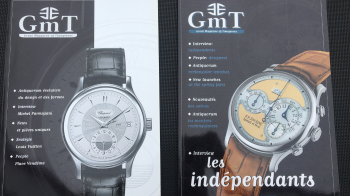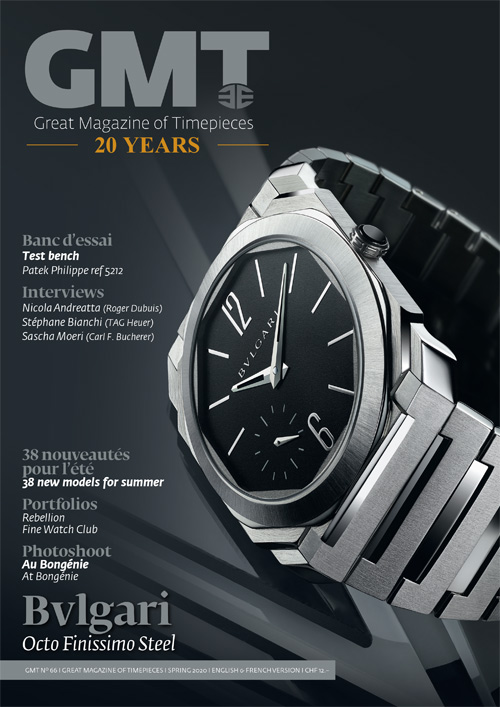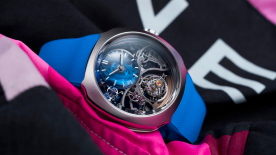And yet it is already on its way, reaching the stars: at the request of the European Space Agency, researchers at the Neuchâtel observatory have developed a new technology to design an extremely precise chronometer designed to equip around thirty positioning satellite dishes with clocks. By coincidence, Rolex presented a meteorite for its new Oyster Perpetual Cosmograph Daytona in white gold dial at the Basel exhibition that year.

Symbols of success
It is also during this palindrome year that GMT chose to launch its annual large-format special edition, the iconic XXL, which focuses on haute horlogerie and promoted it to vacationing clients, often coming from the Middle East at that time. Cartier made the front page of the first issue.

Co-founder of GMT, Pierre Jacques, did not yet know that he would later become CEO of a bold niche brand which was born at the same time: De Bethune. During the SIHH, Roger Dubuis set the scene by inaugurating his new 3000m2 high-tech manufacture—a stone’s throw away from Chopard’s manufacture—continuing the brand’s meteoric rise. The same went for the neighbouring WPHH, where Franck Muller celebrated the 10th anniversary of his company and presented the Tourbillon Revolution, snagging a distinction at the Grand Prix d’Horlogerie de Genève (GPHG) that year. The GPHG awarded Patek Philippe with the Aiguille d’Or for its Ciel Lune wristwatch, Ref. 5102 (see below).
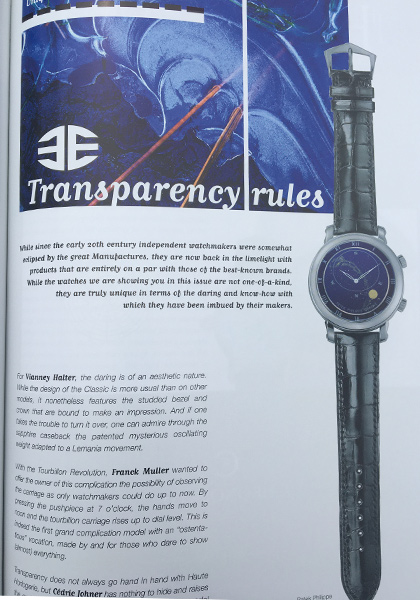
On the other side of the planet, Louis Vuitton took the opportune moment of the Louis Vuitton Cup in Auckland to jump into the water as a watchmaker. The Official Timekeeper of the Louis Vuitton Cup launched a complete collection of watches, the famous Tambour. Alongside them, Audemars Piguet created the Royal Oak City of Sails for Alinghi, Omega dedicated a Seamaster to the America’s Cup and one to Team New Zealand, and TAG Heuer played the US card with an Aquaracer for Oracle. Further north, near the Mariana Islands, Bell & Ross broke the world record for water-resistance with its Hydromax, tested in the deepest ocean trench in the world (11,100m), Challenger. Preferring aerial exploits, Longines celebrated the 75th anniversary of the first non-stop crossing of the Atlantic by Charles Lindbergh, who was then equipped with a Longines. Aimed at pilots but also at men who own their masculinity, IWC designed a Big Pilot’s watch with a diameter of 46mm, featuring a large date and a 7-day power reserve.

For sportsmen and women at ease in all elements, Jaeger-LeCoultre took to the field by presenting its supercharged Master Compressor. Its designers may have been unaware of it at the time, but even today it retains all its aesthetic, timeless and powerful appeal. Less extreme was Vacheron Constantin with the launch of its Royal Eagle sports chronograph. It was the automotive design that Cartier favoured that year with the launch of its Roadster collection, equipped with interchangeable leather and steel bracelets.
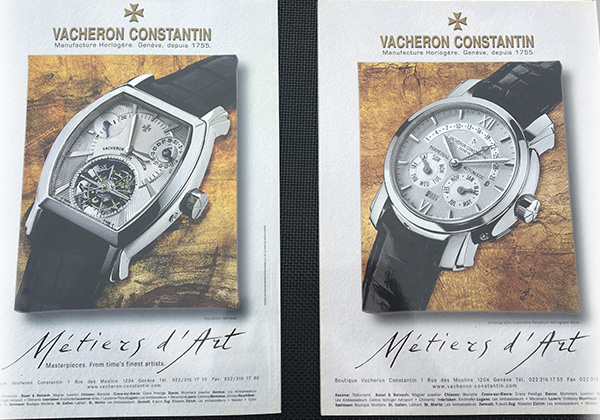
Haute Horlogerie asserts itself
Interviewed by GMT that year, François-Paul Journe had just designed the first self-winding movement with a power reserve that retained a chronometric accuracy of 5 days, housed in the Octa Chronographe. “The turning point was truly taken in 1999, with the growth in understanding from clients,” he says. “In the nineties, there were about 500 collectors in the world capable of understanding and buying grand complications. Today there are 10 times as many. The intrinsic value of the quality complicated watch is recognised, and there is now a clientele that goes beyond the watch to take an interest in pure watchmaking,” he continued.

The same clientele that coveted the skies above Geneva, reproduced on Patek Philippe’s award winning “Ciel Lune”. This patented astronomical watch is distinguished by a system of superimposed sapphire discs rotating at different speeds and creating a magnificent depth effect. The celestial background is represented by a blue sapphire crystal disc integrated into a wheel reflecting the angular movement of the moon, which drives a planetary gear representing the moon phases through a round aperture. The third disc, above, integrated into a wheel with 356 teeth, is made of transparent sapphire glass and features the star map on its upper side and the Milky Way on its lower side. These three discs are protected by sapphire crystal, beneath a gold ellipse marks the sky above Geneva.
Each manufacture brought something new to the reinvigorated Haute Horlogerie. After honouring the 200th anniversary of the invention of the tourbillon in 2001, Breguet expanded the collection with three models celebrating art, women and fine jewellery. Having defined itself as a brand creating “men’s watches that women love”, Girard-Perregaux dedicated to women its Grande Dame Vintage 1945 Petite Seconde & Date Automatique with the Manufacture caliber GP3200. Chopard rolled out the red carpet for its L.U.C collection unveiled a year earlier: it makes the headlines with its first watch equipped with a GMT, the L.U.C GMT with double barrel and 24-hour, and day and night indicator at 6 o’clock, and at the same time presents the only watch in the world with a barrel-shaped movement with automatic winding and off-centre micro-rotor, the L.U.C 6.96 certified COSC.
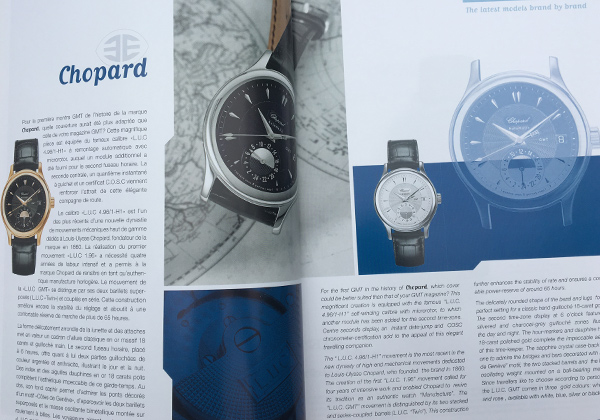
In a completely different style, De Grisogono launched the Instrumento Doppio with its extractable and rotating case, measuring 36x60mm and 18mm thick! For the first time, a double analogue display was featured with a system of hands passing through the oscillating weight. As for Antoine Preziuso, no doubt then imagining his future Tourbillon des Tourbillons, he said what he envied of big brands: “Much more than a marketing department, I would rather have an R&D department. I would very much like to have a group of experts to whom I can submit ideas, discuss them and then delegate projects to.”
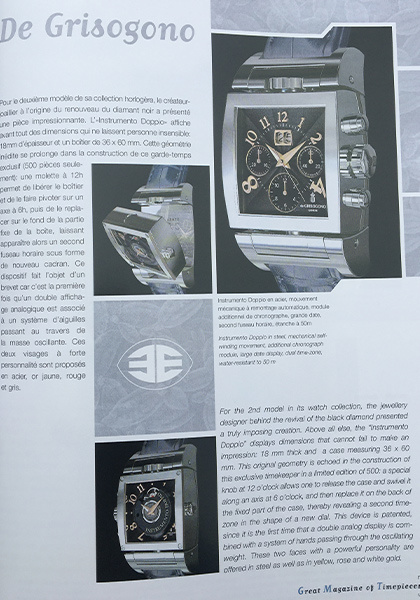
Next week: watchmaking in 2003.
*To celebrate its 20th anniversary in 2020, GMT Magazine will summarise weekly, exclusively on WorldTempus, the essence of its content published year after year in the last 20 years. The information is by no means exhaustive and refers to excerpts. For a more in-depth view of the last two decades of watchmaking, order The Millennium Watch Book produced by GMT Magazine and WorldTempus with the contribution of over twenty experts, each of whom witnessed this incomparable period in our industry.
WorldTempus now offers the GMT Spring 2020 issue, available for download here.
